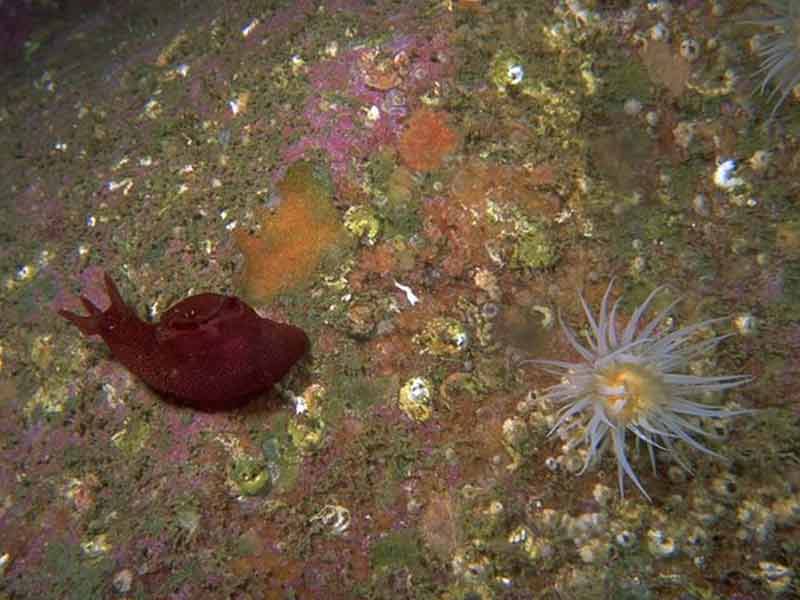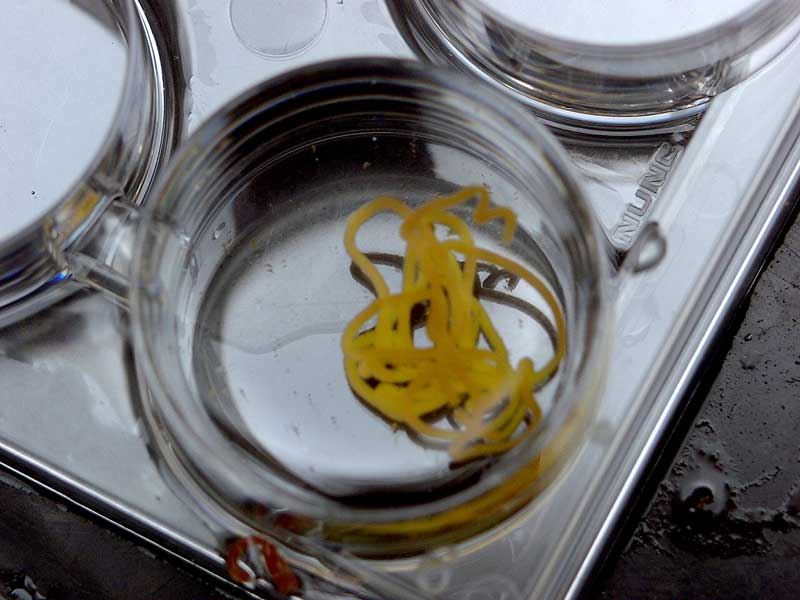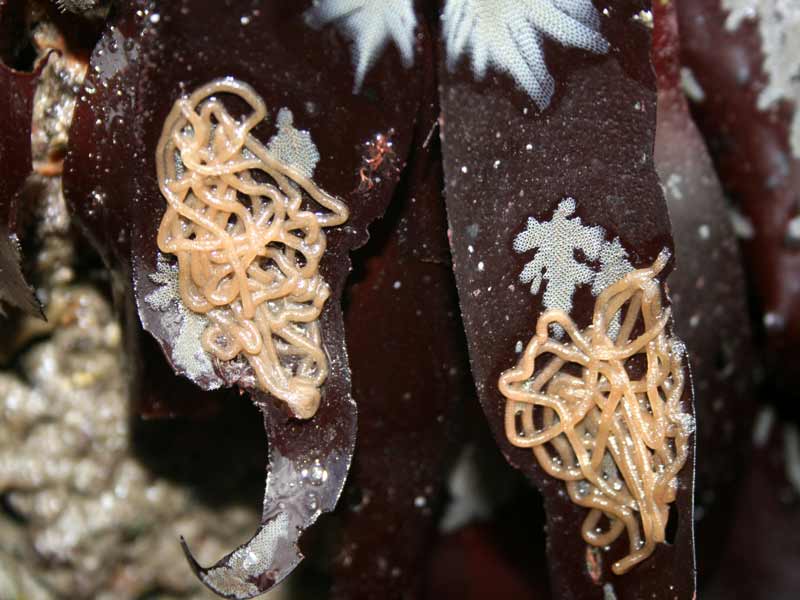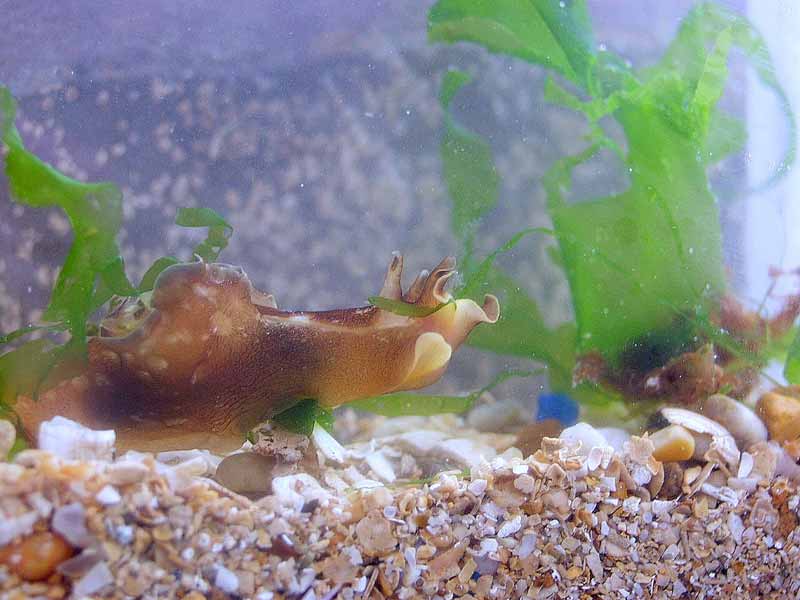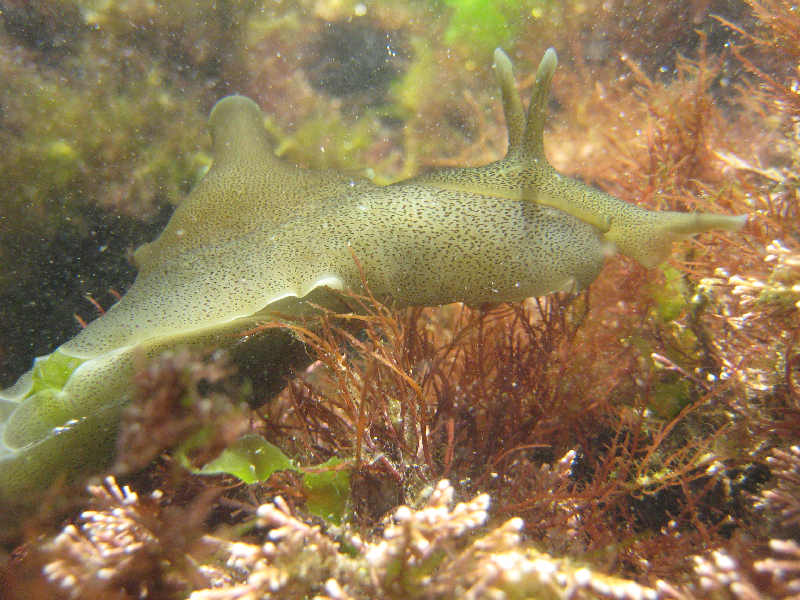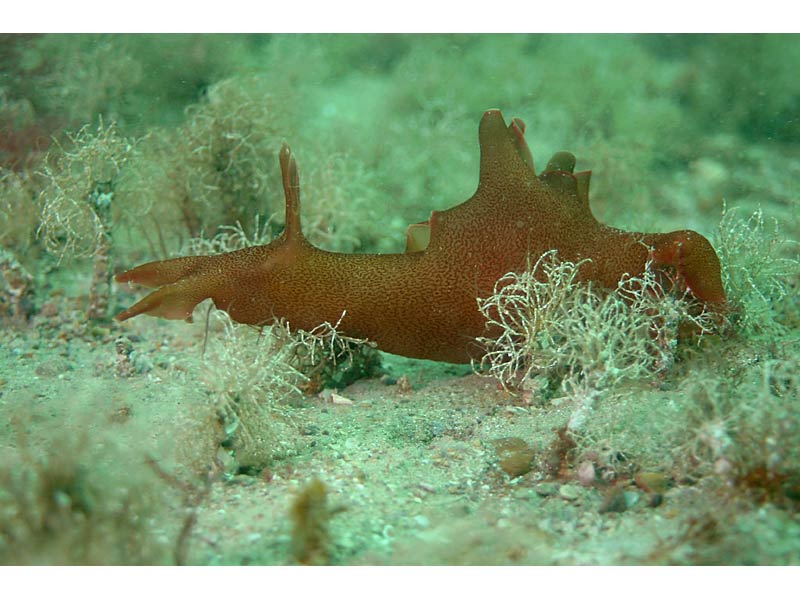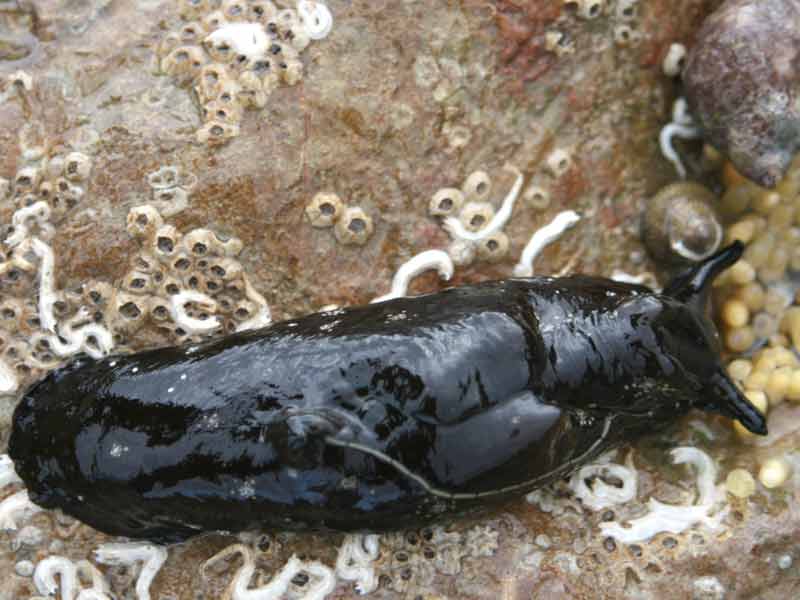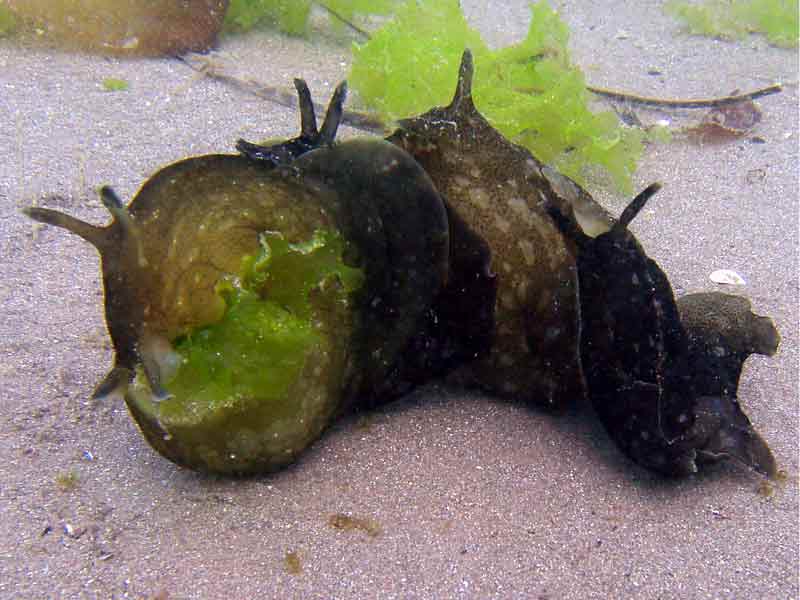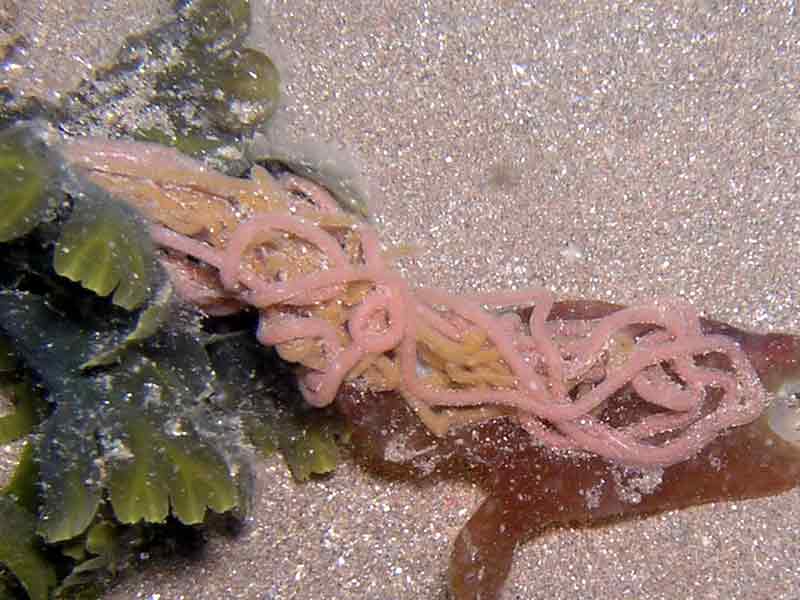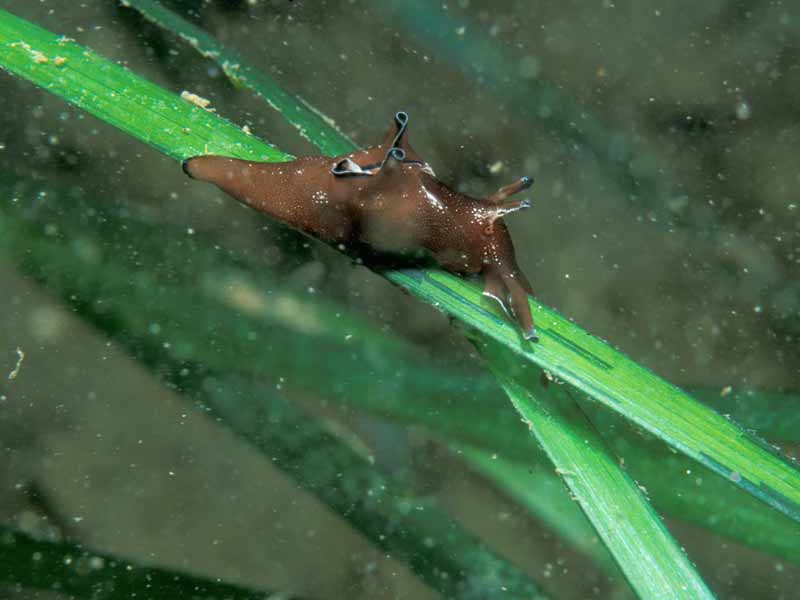Dotted sea hare (Aplysia punctata)
Distribution data supplied by the Ocean Biodiversity Information System (OBIS). To interrogate UK data visit the NBN Atlas.Map Help
| Researched by | Marisa Sabatini | Refereed by | Admin |
| Authority | (Cuvier, 1803) | ||
| Other common names | Small rosy sea hare, Common sea hare | Synonyms | - |
Summary
Description
Aplysia punctata is usually 7 cm long but can grow to 20 cm in length. The body is long and narrow and the parapodia join rather high posteriorly. At the front of the body the anterior tentacles are short, with rounded extensions to the mouth slit while the tentacles on the head (rhinophores) are long and slender. It produces both purple and white secretions when disturbed. The mantle has a large opening (foramen) through which the internal shell may be seen. The internal shell is around 4 cm in length and is transparent and pale amber in colour.
Recorded distribution in Britain and Ireland
Recorded from various locations around the British Isles.Global distribution
-Habitat
Aplysia punctata occurs mainly in very shallow water and occasionally on the lower shore or in rock pools.Depth range
-Identifying features
- Body colour variable ranging from olive, green, brown, red or purplish black.
- Blotches of white and grey, often with black spots and black veining along its body.
- Narrow pedal sole.
- Rarely shows its circular metapodial sucker.
- The penis is not black and is broad and spatulate with no spines.
Additional information
The body colour of Aplysia punctata is said to vary with the character of its algal diet. Therefore, juveniles that feed on red algae are red, whereas the adults, which are said to migrate on shore to breed are brownish or greenish in accordance with their diet (e.g. Ulva and Fucus). It is similar to Aplysia fasciata which is larger and can reach lengths of 40 cm, it is also dark brown or black in colour. The eggs are pink and laid in tangled threads.
Listed by
- none -
Bibliography
Fish, J.D. & Fish, S., 1996. A student's guide to the seashore. Cambridge: Cambridge University Press.
Hayward, P., Nelson-Smith, T. & Shields, C. 1996. Collins pocket guide. Sea shore of Britain and northern Europe. London: HarperCollins.
Howson, C.M. & Picton, B.E., 1997. The species directory of the marine fauna and flora of the British Isles and surrounding seas. Belfast: Ulster Museum. [Ulster Museum publication, no. 276.]
Thompson, T.E., 1976. Biology of Opisthobranch Molluscs, vol. 1. London: The Ray Society.
Datasets
Centre for Environmental Data and Recording, 2018. Ulster Museum Marine Surveys of Northern Ireland Coastal Waters. Occurrence dataset https://www.nmni.com/CEDaR/CEDaR-Centre-for-Environmental-Data-and-Recording.aspx accessed via NBNAtlas.org on 2018-09-25.
Cofnod – North Wales Environmental Information Service, 2018. Miscellaneous records held on the Cofnod database. Occurrence dataset: https://doi.org/10.15468/hcgqsi accessed via GBIF.org on 2018-09-25.
Conchological Society of Great Britain & Ireland, 2018. Mollusc (marine) data for Great Britain and Ireland - restricted access. Occurrence dataset: https://doi.org/10.15468/4bsawx accessed via GBIF.org on 2018-09-25.
Conchological Society of Great Britain & Ireland, 2023. Mollusc (marine) records for Great Britain and Ireland. Occurrence dataset: https://doi.org/10.15468/aurwcz accessed via GBIF.org on 2024-09-27.
Environmental Records Information Centre North East, 2018. ERIC NE Combined dataset to 2017. Occurrence dataset: http://www.ericnortheast.org.ukl accessed via NBNAtlas.org on 2018-09-38
Fenwick, 2018. Aphotomarine. Occurrence dataset http://www.aphotomarine.com/index.html Accessed via NBNAtlas.org on 2018-10-01
Fife Nature Records Centre, 2018. Fife Nature Records Centre combined dataset. Occurrence dataset: https://doi.org/10.15468/ccc1ip accessed via GBIF.org on 2018-09-27.
Manx Biological Recording Partnership, 2022. Isle of Man historical wildlife records 1990 to 1994. Occurrence dataset:https://doi.org/10.15468/aru16v accessed via GBIF.org on 2024-09-27.
National Trust, 2017. National Trust Species Records. Occurrence dataset: https://doi.org/10.15468/opc6g1 accessed via GBIF.org on 2018-10-01.
NBN (National Biodiversity Network) Atlas. Available from: https://www.nbnatlas.org.
OBIS (Ocean Biodiversity Information System), 2025. Global map of species distribution using gridded data. Available from: Ocean Biogeographic Information System. www.iobis.org. Accessed: 2025-08-01
Yorkshire Wildlife Trust, 2018. Yorkshire Wildlife Trust Shoresearch. Occurrence dataset: https://doi.org/10.15468/1nw3ch accessed via GBIF.org on 2018-10-02.
Citation
This review can be cited as:
Last Updated: 08/05/2008


